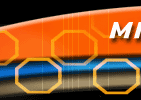




Getting started: The teacher will need to acquire the materials listed, or ask the members of the class to supply them. Students can work in groups of two or three.
Task: Follow the project outline.
Learning
Outcomes:
Familiarizad to work, breaking down all the organic matter.
A sealed vat, though, will build up pressure and burst, from the methane
given off by the microbes, so the gas is vented from the vat and in countries
where energy is at a premium, is often used to power machinery in the
sewage plant. Methane can be used as a fuel both in internal combustion
engines (ie as in your car) and in gas turbines (as in an airliner).
These engines can power pumps and sluices, generate electricity and even
deliver the excess power into the electricity grid system. Thus
your local sewage plant can be eco-friendly, by adding no net increase
in greenhouse gasses or other pollutants to the environment. It
also allows a certainty of power supply to the treatment plant, for it
is not at the mercy of electricity grid or public gas supply. A
failing sewage plant is potentially more hazardous than almost any other
type of civic amenity save perhaps a nuclear power plant. It must
keep working at all costs.
Up to 50% of the sludge can be digested in the vats, but once the process starts to wane the vats are emptied and the waste material can be spread out on the ground to dry in shallow concrete pits. Once this has happened the material can be collected, bagged, and sold as land fertilizer. It is safe to handle and extremely effective in the fields, provided it is free from industrial pollutm">project outline.
Getting started: The teacher will need to acquire the materials listed, or ask the members of the class to supply them. Students can work in groups of two or three.
Task: Follow the project outline.
Learning
Outcomes:
Familiarization with methods of water treatment.
Developing simple construction skills.
Understanding some basic principles in microbiology.
Suitability for students with special needs: Yes. Teachers may need to adapt the experiment according to ability.
Further work: Improve the design. Look at how the system may be adapted for use on a space station in microgravity.
Links:
Water
Microbiology from Washington State University
A sewage treatment plant
Waste in Space
Goal: To demonstrate the effect of enzymes.
Subjects areas: General Science (Biology), Hygiene, Technology.
Basic Activity Time: One Hour
Preparation Time: 30 Minutes
Background Information and References: See the project outline
Getting started: The teacher will need to acquire the materials listed, or ask the members of the class to supply them. Students can work in groups of two of three.
Task: Follow the project outline.
Learning
Outcomes:
Introduction to experimental method.
Familiarization with enzymes.
Understanding the relationship between enzymes and microbiology.
Drawing conclusions from results.
Suitability for students with special needs: Yes. Teachers may need to adapt the experiment according to ability.
Further work: Improve the experiment by varying types of stains (eg organic material compared with inorganic).
Links:
Enzymes
Goal: To introduce students to microscopes and what can be achieved by using them, particularly with respect to microbiology.
Subjects areas: General Science, Biology.
Basic Activity Time: From 30 minutes
Preparation Time: 15 to 30 Minutes
Background Information and References: See the project outline.
Getting started: The teacher will need to set up the microscope or microscopes. If a limited number are available, a rotor system will need to be devised and activities arranged for those not using the microscope(s) at any given time. This might include preparing slides and other materials for viewing.
Task: Follow the project outline.
Learning
Outcomes:
Familiarization with the cell.
Familiarization with microscopes, how they work and what
they do.
Introduction to basic microbiology.
Learning to draw the natural world.
Familiarization with protozoa.
Introduction to the technique of making microscope slides
and staining biological samples.
Suitability for students with special needs: Yes. Teachers may need to adapt the experiment according to ability.
Further work: An enormous range of activities using microscopes, covering many science disciplines is readily available on the internet and elsewhere. Teachers might think about making multi-colored stained slides, once a class is proficient at staining.
Links:
QX3
Computer Microscope
Microscapes
Space Station
Biomedical Lab
Goal: To investigate the problems of interpreting experimental results. The students will also simulate one type of experiment that can be carried out by a robot planetary explorer spacecraft.
Subjects areas: General Science (Experimental Method), Biology, Technology, Environmental Studies.
Basic Activity Time: One Hour
Preparation Time: 30 Minutes
Background Information and References: Follow the project outline.
Getting started: The teacher will need to acquire the materials listed, or ask the members of the class to supply them. Students can work in groups of two or four.
Task: Follow the project outline.
Learning
Outcomes:
Learning scientific and experimental
method and its limitations.
Interpretation of results.
Drawing conclusions from data.
An introduction to the process of
metabolism in microorganisms (yeast).
Learning about planetary exploration.
Suitability for students with special needs: Yes. Teachers may need to adapt the experiment according to ability.
Further work: The basic exercise raises many questions about how scientific results can be interpreted. Students should think about devising new ways to eliminate the ambiguities of this experiment and perhaps try them out.
![]()
Thursday's
Classroom - Planets in a Bottle
Viking Experiments
Life on Mars
Life on other planets
Links to the Guardians Microbiology projects and Classroom
Exercises:
Make a water
recycling system
Experiment
with Enzymes
Using Microscopes
Aliens Soil
Cultures
Exercises
in Microbiology
Links
to practical projects:
The Foundation
for Microbiology
DNA
Extraction Lab by Joseph Windham
Demonstrating
An Epidemic Lab
Demonstration
of Cheese-Making Enzyme Magic
Enzyme
Grabbers
Extraction
of DNA from Onion
Hand
washing Laboratory Activities
DNA
Extraction from Escherichia and coli cells
A
Model of a Bacterial Plasmid
NASA
Microbes Lesson Plan
Computers
in teaching Microbiology
Microbiology
Index - The Search for Life in Space
Microbiology Index - Microbiology on Space Station
2020
Microbiology Index - Microbiology in the Rainforest
Go
to
Home
| Space Station
| Mars | Rainforest
© 1999 Satellite Events Enterprises Inc.